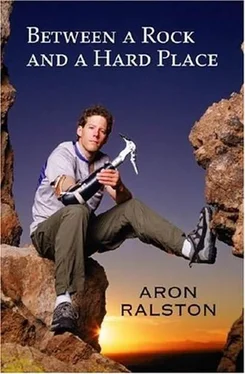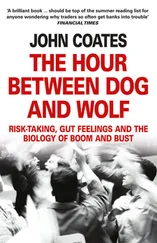Compensating for the banality of my new career in mechanical engineering, I created adventure in my life by exploring Arizona’s vast variety of public lands-canyons, mountains, volcanic cones, meteor craters, deserts, and forests. I met my friend and mentor Mark Van Eeckhout through a college classmate. We both worked at the same clean-room facility in southern Phoenix, and over lunch we would plan out hiking and camping trips.
My college girlfriend, Jamie Zeigler, gave me Edward Abbey’s book Desert Solitaire, which fanned my passion for desert adventure. I became a founding member of the Intel Adventure Club in 1998 when four of my friends from work, including Jamie Stoutenberg and Judson Cole, drafted a plan to hike across the Grand Canyon twice on consecutive days. Starting from the South Rim, we would descend five thousand feet in seven miles via the South Kaibab Trail to cross the Colorado River near Phantom Ranch, then continue fourteen miles on the Bright Angel Trail to the North Rim, climbing six thousand feet up to our campsite. After resting, we would turn around and do it in reverse, North Rim to South Rim. We called it the Rim-to-Rim-to-Rim, or R 3for short.
Just before the trip I was reading Jon Krakauer’s book Into the Wild. The story of young Chris McCandless dropping out of mainstream society to travel around the country entranced me with dreams of living out of the back of a truck and “rubber tramping” across the U.S. I was so caught up in the adventures of Alex Super-tramp, Chris’s nom de voyage, that I carried the book with me across the Grand Canyon on the R 3trip. One passage in particular-from a letter that Chris sent to an older friend he’d met on the road-read like a manifesto:
So many people live within unhappy circumstances and yet will not take the initiative to change their situation because they are conditioned to a life of security, conformity, and conservatism, all of which may appear to give one peace of mind, but in reality nothing is more damaging to the adventurous spirit within a man than a secure future. The very basic core of a man’s living spirit is his passion for adventure. The joy of life comes from our encounters with new experiences, and hence there is no greater joy than to have an endlessly changing horizon, for each day to have a new and different sun.
I wanted to taste that joy, to experience that passion for adventure, to cast away the security of my job and let my spirit roam. This meant I needed to get educated on outdoor living; I needed to gain experience before tackling major expeditions; and I needed to be prepared and mitigate risks. Even more directly, I needed to get a truck and then leave my job. But I had a ways to go before I would be ready to do that.
Another of Krakauer’s books, Into Thin Air, captured my imagination in the winter of 1998. It documented the Mount Everest disaster, in which eleven people died, so compellingly that I felt transported to 26,000 feet on the South Col with Neal Beidleman’s group of lost climbers, just a few hundred yards from Camp IV, wondering what I would do in their place. Exhausted from summit day, pounded by the hellion winds of a blizzard, out of oxygen, and frost-bitten-would I lie there dying? Would I leave the others to save myself? Would I go back to find them if I made it to camp? How would I behave in a situation that caused me to summon the essence of my character? The tragedy inspired me to test myself. I wanted to reveal to myself who I was: the kind of person who died, or the kind of person who overcame circumstances to help himself and others. Not only did I want to go to the Himalayas to climb a major peak, I wanted to explore the depth of my spirit.
And so it was that on March 8, 1998, I set out for a solo winter climb of Humphreys Peak, the highest point in Arizona. Mark lent me snowshoes, an ice axe, and the mountaineering reference Freedom of the Hills, telling me that I needed to master the ice axe techniques it described. Orienteering north from the Snowbowl ski area five miles northwest of Flagstaff, I snowshoed through the pine trees for two hours, following the 10,000-foot contour until I entered a meadow at the base of a long snowfield. From there, I took Mark’s ice axe in my hand and climbed over 2,500 feet up the moderate slope to the summit ridge, where I left the snowshoes smothered in storm. In places, the clouds were so thick that I couldn’t see the drop-off on the right-hand side of the ridge, so I stayed safely to the left, which was, conversely, more exposed to the wind. After a half hour of hiking along the rock-strewn rim of the ancient high volcanic crater, I was shivering hard from the ice-cold blast, but I eventually found the summit, where I squatted behind a hand-stacked wall of rocks at 12,633 feet. Three distant clashes of thunder and lightning collapsed in the clouds to the south.
I couldn’t stay on the summit and risk getting hit by a lightning bolt, but I didn’t want to leave the protection of the rock wall, either. For a fleeting moment, I empathized with that huddling group of lost climbers on the South Col. Here in my own winter whiteout, I was confused, stressed, and lethargic, and I understood a little more personally how the temptation to wait until things got better could, in extremis, turn into deadly apathy. Collecting myself, I stood up from behind the windbreak to face the storm. Staring into a featureless blanket of hazy gray and bracing myself against the wind, I checked my compass to pick a ridgeline to descend. My ascending footprints had been obliterated in seconds.
Forcing my way down, I kept my eyes searching for Mark’s snowshoes. I had left them on the ridge at the top of the snowfield, marking the turn where I would descend into the trees and get out of the storm. Above the gale, I noticed a hissing sound coming from my pack. I stopped to check it out and saw small blue sparks discharge between the metal tips of my ski poles. Idiotically, I had lashed them onto my pack so that the tips were three feet above my head, and they were attracting lightning. I dropped the pack and dove onto a patch of snow faster than I had ever moved on a mountainside. Panting, I dragged my pack beside me as I scooted off the ridge on my belly. When I felt safe to stand up, I ran for my life. After a minute, I slowed down when a momentary break in the clouds showed me Mark’s snowshoes just above. I ditched my pack to retrieve them and made it back to my truck two hours later without further incident.
There are patterns to my climbing style that first sprouted on this ascent of Humphreys Peak-traveling by myself, climbing through storms, making solid route-finding decisions in demanding situations, and getting lucky around lightning. This climb was also a confidence builder for me: My awareness was heightened, and in that awareness I felt more deeply alive.

After my adventure on Humphreys Peak, Mark and I spoke often about my plan to solo-climb all the fourteeners in Colorado in winter. Mark knew I was too inexperienced to tackle such a risky project, but he also knew that I was intent on getting the project going. He taught me the basics of rock climbing, rope work, avalanche awareness, and snow travel. We went on beginner-level climbing excursions around central Arizona, took trips to the indoor rock climbing gym in Tempe, and over Labor Day weekend of 1998, Mark led my friend Howard and me on my first multi-pitch alpine rock climb on Vestal Peak in the San Juan Mountains of Colorado.
Vestal Peak was especially memorable, as Mark taught us to handle the fear we felt before and during the climb of the two-thousand-foot-high slab of granite that tops out at nearly 14,000 feet. Halfway up the center of the north face, the soles of both my climbing boots blew out within minutes of each other, the stitching of the heels just disintegrating under the stress of the ascent, leaving me with the equivalent of massive flip-flops for the upper part of the route.
Читать дальше













